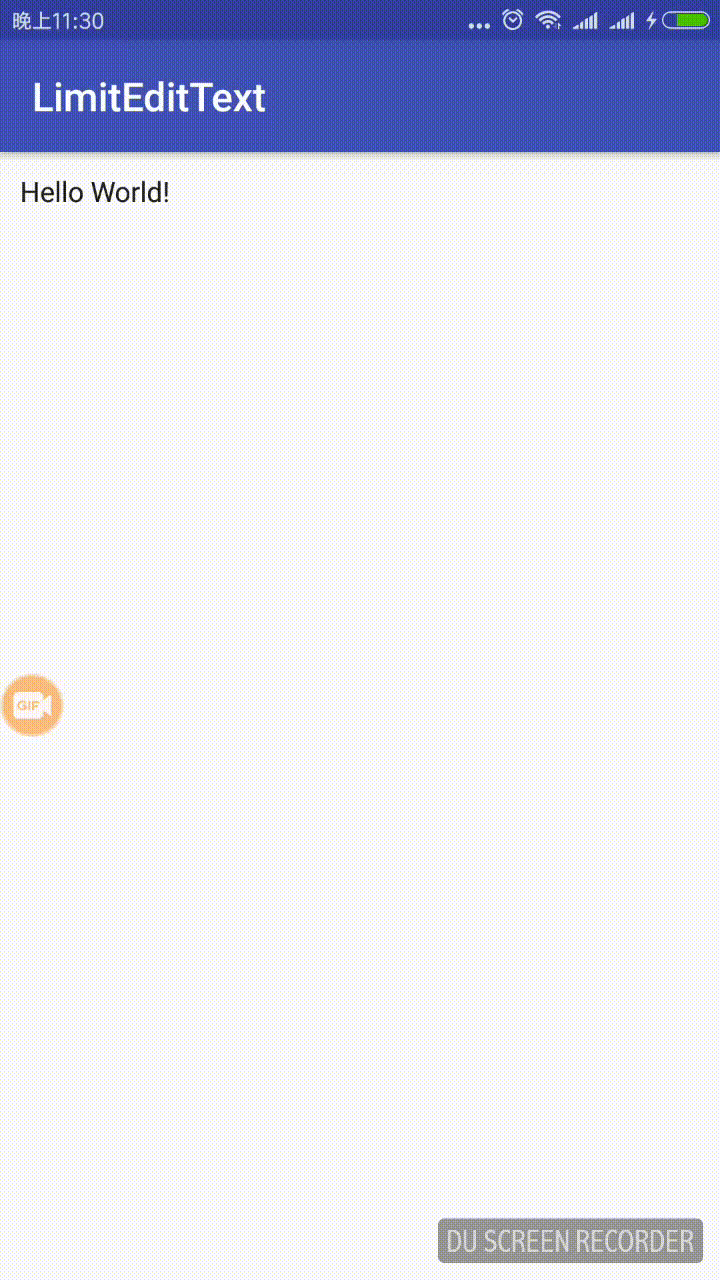前言
Android的编辑框控件EditText在平常编程时会经常用到,有时候会对编辑框增加某些限制,如限制只能输入数字,最大输入的文字个数,不能输入一些非法字符等,本文就来给大家介绍了一种最简单的输入限制方法。
效果图

Github地址,欢迎点赞,fork
今天带来工作中的一个小安利,产品要求对用户名输入需要限制,只能是数字和字母,符号,不能包含空格和键盘上输入的emoji.开始拿到这个需求,觉得给 EditText 增加一个 addTextChangedListener ,里面做各种判断不就OK 啦!
哈哈,又可以愉快的玩耍咯...
但是回调里面逻辑太多,看着也不爽,不符合我们程序员的气质,简洁大方,干净利落!所以我特意去看了 du 了一下, 结合自己的实际要求,重写了 EditText 的 onCreateInputConnection() 方法,在那里做文章,请看下面源码(如果还有不清楚的,可以留言或者看Github地址)
方法如下:
只需要自定义EditText重写其onCreateInputConnection()方法,然后再定义一个内部类就好,下面代码即拷即用
首先,看看 LimitEditText
class LimitEditText(context: Context, attrs: AttributeSet, defStyleAttr: Int) : EditText(context, attrs, defStyleAttr) { constructor(context: Context, attrs: AttributeSet) : this(context, attrs, 0) /** * 输入法 */ override fun onCreateInputConnection(outAttrs: EditorInfo?): InputConnection { return InnerInputConnection(super.onCreateInputConnection(outAttrs), false) }}class InnerInputConnection(target: InputConnection, mutable: Boolean) : InputConnectionWrapper(target, mutable) { // 数字,字母 private val pattern = Pattern.compile("^[0-9A-Za-z_]/$") // 标点 private val patternChar = Pattern.compile("[^//w//s]+") // EmoJi private val patternEmoJi = Pattern.compile("[/ud83c/udc00-/ud83c/udfff]|[/ud83d/udc00-/ud83d/udfff]|[/u2600-/u27ff]", Pattern.UNICODE_CASE or Pattern.CASE_INSENSITIVE) // 英文标点 private val patternEn = Pattern.compile("^[`~!@#/$%^&*()_//-+=<>?:/"{},./////;'//[//]]/$") // 中文标点 private val patternCn = Pattern.compile("^[·!#¥(——):;“”‘、,|《。》?、【】//[//]]/$") // 对输入拦截 override fun commitText(text: CharSequence?, newCursorPosition: Int): Boolean { if (patternEmoJi.matcher(text).find()){ return false } if (pattern.matcher(text).matches() || patternChar.matcher(text).matches()) { return super.commitText(text, newCursorPosition) } return false }} 总计60行代码,可以搞定一般需求啦,再来看看其布局用法(xml文件),平时怎么在布局写EditText,还是怎么写!
<?xml version="1.0" encoding="utf-8"?><android.support.constraint.ConstraintLayout xmlns:android="http://schemas.android.com/apk/res/android" xmlns:app="http://schemas.android.com/apk/res-auto" xmlns:tools="http://schemas.android.com/tools" android:layout_width="match_parent" android:layout_height="match_parent" tools:context="cn.molue.jooyer.limitedittext.MainActivity"> <cn.molue.jooyer.limitedittext.LimitEditText android:id="@+id/let_main" android:layout_width="match_parent" android:layout_height="50dp" android:layout_margin="10dp" android:text="Hello World!" app:layout_constraintLeft_toLeftOf="parent" app:layout_constraintRight_toRightOf="parent" app:layout_constraintTop_toTopOf="parent"/></android.support.constraint.ConstraintLayout>
最后来看看在 Activity 中用法,其实和一般普通 EditText 用法一致啦!
class MainActivity : AppCompatActivity() { override fun onCreate(savedInstanceState: Bundle?) { super.onCreate(savedInstanceState) setContentView(R.layout.activity_main) // demo 中默认 LimitEditText 只能输入字母数字和标点符号 // 延时主要是更方便观察 window.decorView.postDelayed({ // 注意,获得焦点需要自己再处理下,其实很简单,如下: let_main.isFocusable = true let_main.isFocusableInTouchMode = true let_main.requestFocus() },1000) }} 当然,这些限制正则也可以在 LimitEditText 中定义方法,大家需要什么加入什么就好了!
总结
以上就是这篇文章的全部内容了,希望本文的内容对大家的学习或者工作具有一定的参考学习价值,如果有疑问大家可以留言交流,谢谢大家对VEVB武林网的支持。
注:相关教程知识阅读请移步到Android开发频道。